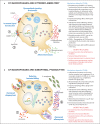Cystic Fibrosis Lung Immunity: The Role of the Macrophage
- PMID: 27336915
- PMCID: PMC5089923
- DOI: 10.1159/000446825
Cystic Fibrosis Lung Immunity: The Role of the Macrophage
Abstract
Cystic fibrosis (CF) pathophysiology is hallmarked by excessive inflammation and the inability to efficiently resolve lung infections, contributing to major morbidity and eventually the mortality of patients with this disease. Macrophages (MΦs) are major players in lung homeostasis through their diverse contributions to both the innate and adaptive immune networks. The setting of MΦ function and activity in CF is multifaceted, encompassing the response to the unique environmental cues in the CF lung as well as the intrinsic changes resulting from CFTR dysfunction. The complexity is further enhanced with the identification of modifier genes, which modulate the CFTR contribution to disease, resulting in epigenetic and transcriptional shifts in MΦ phenotype. This review focuses on the contribution of MΦ to lung homeostasis, providing an overview of the diverse literature and various perspectives on the role of these immune guardians in CF.
© 2016 S. Karger AG, Basel.
Conflict of interest statement
The authors declare no conflict of interest.
Figures


References
-
- Hussell T, Bell TJ. Alveolar macrophages: plasticity in a tissue-specific context. Nat Rev Immunol. 2014;14:81–93. - PubMed
-
- Soehnlein O, Lindbom L. Phagocyte partnership during the onset and resolution of inflammation. Nat Rev Immunol. 2010;10:427–439. - PubMed
-
- Okabe Y, Medzhitov R. Tissue biology perspective on macrophages. Nat Immunol. 2015;17:9–17. - PubMed
-
- Byrne AJ, Mathie SA, Gregory LG, Lloyd CM. Pulmonary macrophages: key players in the innate defence of the airways. Thorax. 2015;70:1189–1196. - PubMed
Publication types
MeSH terms
Substances
Grants and funding
LinkOut - more resources
Full Text Sources
Other Literature Sources
Medical

